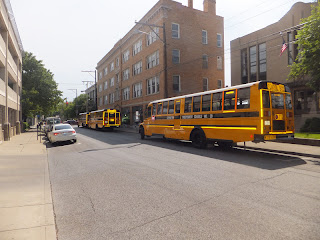by Michael Monks
|
|
THE RIVER CITY NEWS MORE COVINGTON NEWS THAN ANY OTHER SOURCE
|
Three buses loaded with people departed Covington City Hall Wednesday afternoon for a tour of black history through Covington, Newport, Elsmere, and the National Underground Railroad Freedom Center in Downtown Cincinnati. The event was created in honor of April's designation as Fair Housing Month and in conjunction with the 44th anniversary of the Federal Fair Housing Act of 1968. The Get on the Bus tour was sponsored by the Lexington Fair Housing Council which also provided lunch catered by T's in Covington's Eastside.
|
From the tour's brochure:
The ethnic and racial makeup of the East End of Covington included Irish and German immigrants and African Americans. In 1880, small numbers of African Americans began to concentrate in the area around Washington Street and the railroad and in homes along the alleys between Fifth and Sixth Streets east of Madison Avenue. Between 1880 and 1910, there was a population surge among the African Americans, and larger groups of blacks began living between 8th & 11th Streets near Greenup Street. In 1880, the streets in this area were only partially completed, and the inhabitants were a mixture of African Americans, whites, and German and Irish immigrants. In 1890, African Americans began to cluster on Washington Street and also settled in large numbers between 5th and 6th Streets near Scott Boulevard and Madison Avenue in the Central Business District. The Civil Rights era of the 1950s through the 1970s brought a change of focus in the neighborhood. The East End came to be known as the Eastside, and streets and homes once banned from African American occupancy became available to them. In the early 1970s, the City of Covington passed an open-housing law finally permitting African Americans to live anywhere in the city. Immigration in the 19th century filled up the city's West Side, bringing European architecture, shops, and crafts. Houses sat on narrow lots and high population density made walking a convenience. The German and Irish immigrants of the West Side supported a host of saloons, stores, and institutions. West Side German culture became a victim of the anti-German hysteria of World War I. In th 1960s, urban renewal took its toll on the West Side.
|
SEE THE FULL BROCHURE WITH PHOTOS AND DETAILS FROM OUR SURROUNDING COMMUNITIES: Click Here (PDF)
|
Covington Mayor Chuck Scheper applauded the tour in a press release Wednesday morning. "The city of Covington is pleased to be hosting this celebratory, informative and educational program. Covington is a unique city that exhibits a tremendous history of the progress which has been made from segregation to our Human Rights Ordinance. We have made great strides and believe that no one should be discriminated against - in any capacity for any reason. We celebrate our diversity and embrace the members of our community." Scheper said. "This tour is a unique experience for attendees to hear the sometimes less-known history behind many of our special and historic structures, as presented by tour guides who share their personal experiences of living through changing times over past decades. Covington is honored to have been chosen as a site for this year's celebration of Fair Housing Month and the Fair Housing Act of 1968."
|
Each of the three buses featured a guest narrators and tour guides including local historian Ted Harris, Elsmere Mayor Billy Bradford, retired Covington businessman/entertainer Fred Hollis, Eastside neighborhood leader Bennie Doggett, Newport pastor W.L. Taylor, retired Elsmere police officer Allen Thomas, Covington pastor Richard Fowler, Newport community activist Patricia Headen, Covington school board member Jerry Avery, and former Newport newspaper publisher Patricia Fann, and John CK Fischer of the Kentucky Human Rights Commission.
|
Each of the three buses featured a guest narrators and tour guides including local historian Ted Harris, Elsmere Mayor Billy Bradford, retired Covington businessman/entertainer Fred Hollis, Eastside neighborhood leader Bennie Doggett, Newport pastor W.L. Taylor, retired Elsmere police officer Allen Thomas, Covington pastor Richard Fowler, Newport community activist Patricia Headen, Covington school board member Jerry Avery, and former Newport newspaper publisher Patricia Fann, and John CK Fischer of the Kentucky Human Rights Commission.



No comments:
Post a Comment